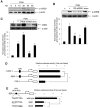Peptidoglycan from Staphylococcus aureus increases MUC5AC gene expression via RSK1-CREB pathway in human airway epithelial cells
- PMID: 21904880
- PMCID: PMC3887644
- DOI: 10.1007/s10059-011-0118-3
Peptidoglycan from Staphylococcus aureus increases MUC5AC gene expression via RSK1-CREB pathway in human airway epithelial cells
Abstract
Respiratory tract exposure to viruses, air pollutants, or bacterial pathogens can lead to pulmonary diseases. The molecular mechanism of mucous overproduction increased by these pathogens provides the knowledge for developing new therapeutic strategies. There is established in vitro data demonstrating that the overexpression of MUC5AC is induced by peptidoglycan (PGN) derived from Staphylococcus aureus. However, the mechanisms by which PGN activates MUC5AC gene expression in the airway remain unclear. The aim of this study was to identify the mechanism of PGN-induced MUC5AC gene expression. We found that PGN could induce MUC5AC gene expressions in a time- and dose-dependent manner. Moreover, activations of ERK1/2 and JNK increased after treatment of cells with PGN, whereas phosporylation of p38 was undetected. Of these MAPKs, pharmacologic inhibition of ERK1/2 decreased PGN-induced MUC5AC gene expression. In addition, we checked the activation of p90 ribosomal S6 kinase 1 (RSK1) as a downstream signaling target of ERK1/2 in PGN signaling. The activation of RSK1 was prevented by pretreatment with PD98059. We also found that RSK1 mediated the PGN-induced phosphorylation of cAMP response element-binding protein (CREB) and the transcription of MUC5AC. Furthermore, the cAMP-response element (CRE) in the MUC5AC promoter appears to be important for PGN-induced MUC5AC gene expression in NCI-H292 cells.
Figures




Similar articles
-
Upregulation of MUC5AC gene expression by IL-4 through CREB in human airway epithelial cells.J Cell Biochem. 2009 Nov 1;108(4):974-81. doi: 10.1002/jcb.22330. J Cell Biochem. 2009. PMID: 19718656
-
The extracellular signal-regulated kinase mitogen-activated protein kinase/ribosomal S6 protein kinase 1 cascade phosphorylates cAMP response element-binding protein to induce MUC5B gene expression via D-prostanoid receptor signaling.J Biol Chem. 2011 Sep 30;286(39):34199-214. doi: 10.1074/jbc.M111.247684. Epub 2011 Aug 10. J Biol Chem. 2011. PMID: 21832046 Free PMC article.
-
cAMP-responding element-binding protein and c-Ets1 interact in the regulation of ATP-dependent MUC5AC gene expression.J Biol Chem. 2008 Oct 3;283(40):26869-78. doi: 10.1074/jbc.M802507200. Epub 2008 Aug 1. J Biol Chem. 2008. PMID: 18676374
-
Interleukin-1 beta and tumor necrosis factor-alpha induce MUC5AC overexpression through a mechanism involving ERK/p38 mitogen-activated protein kinases-MSK1-CREB activation in human airway epithelial cells.J Biol Chem. 2003 Jun 27;278(26):23243-50. doi: 10.1074/jbc.M300096200. Epub 2003 Apr 10. J Biol Chem. 2003. PMID: 12690113
-
A Review on the Extraction, Structural Characterization, Function, and Applications of Peptidoglycan.Macromol Rapid Commun. 2025 Mar;46(5):e2400654. doi: 10.1002/marc.202400654. Epub 2025 Jan 2. Macromol Rapid Commun. 2025. PMID: 39748598 Review.
Cited by
-
Pseudomonas aeruginosa Quorum Sensing Molecule N-(3-Oxododecanoyl)-L-Homoserine-Lactone Induces HLA-G Expression in Human Immune Cells.Infect Immun. 2015 Oct;83(10):3918-25. doi: 10.1128/IAI.00803-15. Epub 2015 Jul 20. Infect Immun. 2015. PMID: 26195547 Free PMC article.
-
A GNAS mutation found in pancreatic intraductal papillary mucinous neoplasms induces drastic alterations of gene expression profiles with upregulation of mucin genes.PLoS One. 2014 Feb 3;9(2):e87875. doi: 10.1371/journal.pone.0087875. eCollection 2014. PLoS One. 2014. PMID: 24498386 Free PMC article.
-
Aromadendrin Ameliorates Airway Inflammation in Experimental Mice with Chronic Obstructive Pulmonary Disease.J Microbiol Biotechnol. 2024 Nov 19;35:e2408022. doi: 10.4014/jmb.2408.08022. J Microbiol Biotechnol. 2024. PMID: 39639498 Free PMC article.
-
Staphylococcus aureus Biofilm Growth on Cystic Fibrosis Airway Epithelial Cells Is Enhanced during Respiratory Syncytial Virus Coinfection.mSphere. 2018 Aug 15;3(4):e00341-18. doi: 10.1128/mSphere.00341-18. mSphere. 2018. PMID: 30111629 Free PMC article.
-
The Neuropeptide Galanin Is Up-Regulated during Cholestasis and Contributes to Cholangiocyte Proliferation.Am J Pathol. 2017 Apr;187(4):819-830. doi: 10.1016/j.ajpath.2016.12.015. Epub 2017 Feb 11. Am J Pathol. 2017. PMID: 28196718 Free PMC article.
References
-
- Kim C.H., Kim K.E., Yoon J.H., Song K.S. Upregulation of MUC5AC gene expression by IL-4 through CREB in human airway epithelial cells. J. Cell. Biochem. (2009);108:974–981. - PubMed
-
- Lemjabbar H., Basbaum C. Platelet-activating factor receptor and ADAM10 mediate responses to Staphylococcus aureus in epithelial cells. Nat. Med. (2002);8:41–46. - PubMed
-
- Martinon F., Agostini L., Meylan E., Tschopp J. Identification of bacterial muramyl dipeptide as activator of the NALP3/cryopyrin inflammasome. Curr. Biol. (2004);14:1929–1934. - PubMed
-
- Mayr B., Montminy M. Transcriptional regulation by the phosphorylation-dependent factor CREB. Nat. Rev. Mol. Cell Biol. (2001);2:599–609. - PubMed
Publication types
MeSH terms
Substances
LinkOut - more resources
Full Text Sources
Medical
Research Materials
Miscellaneous

